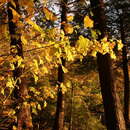More info on this topic. More info for the terms:
climax,
forest,
litterEastern hemlock is very shade tolerant [
5]. Seedlings survive in as
little as 5 percent of full light [
14]. Individuals are able to survive
several hundred years of suppression, and many show numerous growth
releases and suppressions [
6]. Saplings less than 2 inches (5 cm) in
d.b.h. may be more than 100 years old [
10].
Seedlings are able to establish under the canopy of mature individuals.
Eastern hemlock establishes under dense sugar maple canopies and can
replace that species [
39]. Eastern hemlock uniquely modifies
semipermanent soil properties, such as acidity, which favors its
reproduction. Opportunities to establish in a mature forest increase
over time as nurse logs and tip-up mounds accumulate [
51].
The general designation of eastern hemlock as a climax species has been
questioned [
22,
41]. In some old-growth eastern hemlock stands, the
smaller size classes of hemlock are being replaced by American beech
(Fagus grandifolia) and sugar maple [
41]. Because of this lack of
regeneration, Hemond and others [
22] suggest that eastern hemlock
requires disturbance to perpetuate itself.
In contrast, other authors suggest that disturbance is responsible for
the lack of regeneration in mature hemlock forests [
3,
6,
51].
White-tailed deer populations have increased since presettlement times
because logging of virgin forests opened up habitat, predators declined,
and the deer were protected. Deer often consume all eastern hemlock
seedlings and saplings in the winter. Where deer populations are low,
eastern hemlock appears to be able to reproduce in its own shade and
become a component of a self-perpetuating homogenous climax forest [
3].
Eastern hemlock requires partial shade for establishment and is a late
colonizer of disturbed sites [
24]. In the Pisgah Forest in southwestern
New Hampshire, 80 percent of old-growth eastern hemlock established
within 37 years of disturbance. Hardwoods grew rapidly into the canopy
while eastern hemlock grew slowly as shade-tolerant saplings. Eastern
hemlock extended into the canopy following subsequent disturbance [
23].
The understory population of eastern hemlock readily takes advantage of
canopy gaps. Eastern hemlock increased in importance as American
chestnut (Castanea dentata) declined from chestnut blight [
8]. It is
currently replacing American beech where that species is succumbing to
beech bark disease [
53]. Eastern hemlock is not successful in
regenerating in canopy gaps in areas such as the New York Botanical
Forest, where the occasional light arson fire, trampling, and other
urban stresses kill seedlings. In addition, the removal of fallen logs
in the forest decreases the amount of adequate substrate for germination
[
52].
The slow invasion of oak-dominated sites by eastern hemlock appears to
be related to heavy leaf litter and the absence of favorable seedbed
conditions [
22].

